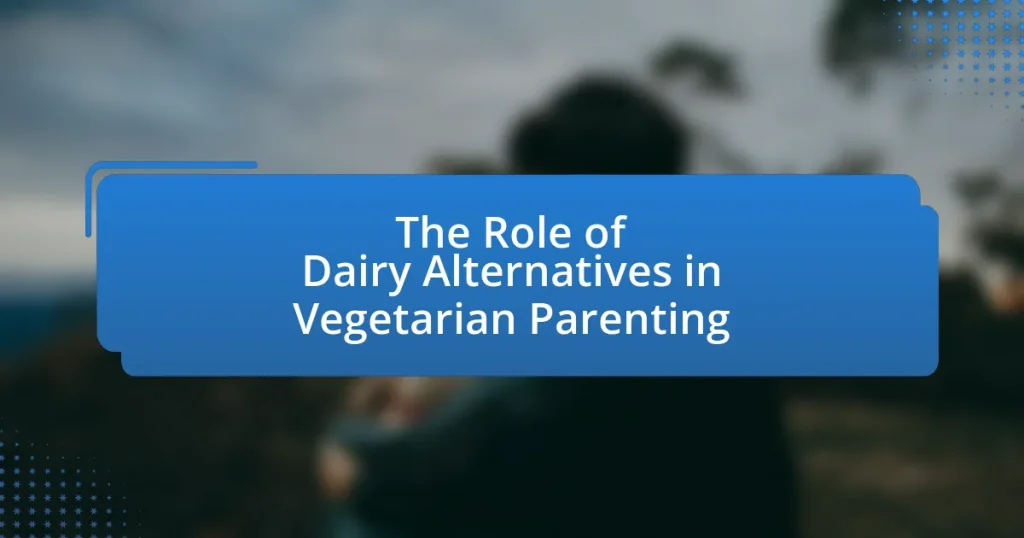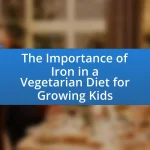Dairy alternatives are plant-based substitutes for traditional dairy products, including milk, cheese, and yogurt, and play a significant role in vegetarian parenting. These alternatives, such as almond milk, soy milk, and coconut yogurt, provide essential nutrients like calcium and vitamin D, which are vital for children’s growth and development. The article explores the nutritional benefits of dairy alternatives, their suitability in vegetarian diets, and the various types available for families. It also addresses common misconceptions, challenges parents face when introducing these alternatives, and strategies to ensure a balanced diet while meeting children’s dietary needs. Additionally, the article highlights the ethical and environmental advantages of choosing dairy alternatives, making them an appealing option for health-conscious and environmentally aware families.

What are Dairy Alternatives and Their Importance in Vegetarian Parenting?
Dairy alternatives are plant-based products that serve as substitutes for traditional dairy products, including milk, cheese, and yogurt. These alternatives, such as almond milk, soy milk, and coconut yogurt, are important in vegetarian parenting because they provide essential nutrients like calcium and vitamin D, which are crucial for children’s growth and development. Research indicates that many dairy alternatives are fortified with these nutrients, making them comparable to cow’s milk in terms of nutritional value. Additionally, dairy alternatives can help prevent lactose intolerance issues and cater to children with dairy allergies, ensuring a balanced diet while adhering to vegetarian principles.
How do dairy alternatives fit into a vegetarian diet for children?
Dairy alternatives are essential components of a vegetarian diet for children, providing necessary nutrients while avoiding animal products. These alternatives, such as almond milk, soy milk, and oat milk, often contain added calcium and vitamin D, which are crucial for children’s bone development. Research indicates that fortified plant-based milks can offer similar nutritional benefits to cow’s milk, making them suitable substitutes in a vegetarian diet. For instance, a study published in the Journal of the American Dietetic Association highlights that children consuming fortified plant-based beverages can meet their calcium needs effectively.
What types of dairy alternatives are available for vegetarian families?
Vegetarian families have access to a variety of dairy alternatives, including plant-based milks, yogurts, cheeses, and creams. Common types of plant-based milks include almond, soy, oat, coconut, and rice milk, each offering unique flavors and nutritional profiles. Plant-based yogurts are often made from soy, almond, coconut, or cashew bases, providing similar textures and flavors to traditional dairy yogurts. Vegan cheeses, derived from nuts, soy, or coconut, are available in various forms such as slices, shreds, and spreads, catering to different culinary needs. Additionally, plant-based creams, often made from cashews or soy, can be used in cooking and baking as substitutes for dairy cream. These alternatives are widely available in grocery stores and are increasingly fortified with vitamins and minerals to match the nutritional content of dairy products.
How do these alternatives compare nutritionally to traditional dairy?
Dairy alternatives, such as almond milk, soy milk, and oat milk, generally have lower calories and fat compared to traditional dairy products like whole milk. For instance, unsweetened almond milk contains about 30-50 calories per cup, while whole milk has approximately 150 calories. Additionally, many dairy alternatives are fortified with vitamins and minerals, such as calcium and vitamin D, to match the nutritional profile of dairy. However, they often contain less protein; for example, soy milk has about 7 grams of protein per cup, while whole milk has around 8 grams. This nutritional comparison highlights that while dairy alternatives can provide essential nutrients, they may vary significantly in protein content and overall caloric value.
Why are dairy alternatives becoming popular among vegetarian parents?
Dairy alternatives are becoming popular among vegetarian parents primarily due to health concerns and dietary preferences. Many vegetarian parents seek plant-based options that align with their lifestyle, as these alternatives often contain lower levels of saturated fat and cholesterol compared to traditional dairy products. Additionally, dairy alternatives, such as almond milk, soy milk, and oat milk, provide essential nutrients like calcium and vitamin D, which are important for children’s growth and development. Research indicates that the global plant-based milk market is projected to reach $21 billion by 2024, reflecting a significant shift in consumer preferences towards healthier and more sustainable food choices. This trend is further supported by studies showing that plant-based diets can reduce the risk of chronic diseases, making dairy alternatives an appealing option for health-conscious families.
What health benefits do dairy alternatives provide for children?
Dairy alternatives provide several health benefits for children, including improved digestion, reduced risk of allergies, and enhanced nutrient intake. These alternatives, such as almond milk, soy milk, and oat milk, often contain added vitamins and minerals like calcium and vitamin D, which are essential for bone health. Research indicates that children who consume fortified dairy alternatives can achieve similar nutrient levels to those who consume cow’s milk, supporting overall growth and development. Additionally, dairy alternatives are typically lower in saturated fat and cholesterol, contributing to better heart health in children.
How do dairy alternatives support ethical and environmental values in parenting?
Dairy alternatives support ethical and environmental values in parenting by providing plant-based options that reduce animal suffering and lower carbon footprints. These alternatives, such as almond, soy, and oat milk, are often produced with fewer resources and generate less greenhouse gas emissions compared to traditional dairy farming. For instance, a study published in the journal “Nature” found that dairy production is responsible for 3.2 times more greenhouse gas emissions per calorie than plant-based alternatives. By choosing dairy alternatives, parents can align their dietary choices with values of compassion towards animals and sustainability, fostering a more environmentally conscious upbringing for their children.

What Challenges Do Parents Face When Introducing Dairy Alternatives?
Parents face several challenges when introducing dairy alternatives, including nutritional concerns, taste preferences, and potential allergies. Nutritional concerns arise because parents must ensure that dairy alternatives provide adequate calcium, vitamin D, and protein, which are typically abundant in cow’s milk. For instance, some plant-based milks may lack these essential nutrients unless fortified. Taste preferences can also be a hurdle, as children may resist the flavor or texture of dairy alternatives, making it difficult for parents to encourage their consumption. Additionally, parents must be vigilant about potential allergies, as some dairy alternatives, such as soy or nuts, can trigger allergic reactions in sensitive individuals. These challenges require parents to be informed and proactive in selecting appropriate dairy alternatives that meet their children’s dietary needs while also considering their preferences and safety.
What common misconceptions exist about dairy alternatives?
Common misconceptions about dairy alternatives include the belief that they are nutritionally inferior to cow’s milk, that they are always lactose-free, and that they lack protein. Research indicates that many dairy alternatives, such as fortified almond or soy milk, can provide comparable levels of vitamins and minerals, including calcium and vitamin D, essential for children’s growth. Additionally, while some dairy alternatives are lactose-free, not all are; for example, certain brands of oat milk may still contain trace amounts of lactose. Furthermore, while soy milk is a good source of protein, other alternatives like almond or rice milk typically contain lower protein levels, which can be misleading for parents considering these options for their children.
How can parents address concerns about protein intake from dairy alternatives?
Parents can address concerns about protein intake from dairy alternatives by ensuring that these alternatives are fortified with protein or by incorporating other protein-rich foods into their child’s diet. Many dairy alternatives, such as soy milk, almond milk, and oat milk, can be fortified with additional protein, making them comparable to cow’s milk. For instance, soy milk typically contains about 7-8 grams of protein per cup, similar to cow’s milk. Additionally, parents can include legumes, nuts, seeds, and whole grains in meals to enhance overall protein intake. Research indicates that a well-planned vegetarian diet can meet protein needs effectively, as long as a variety of protein sources are included.
What strategies can parents use to overcome resistance from children?
Parents can use positive reinforcement, open communication, and gradual exposure to overcome resistance from children. Positive reinforcement involves rewarding children for trying new dairy alternatives, which can encourage them to be more open to these options. Open communication allows parents to understand their children’s preferences and concerns, fostering a supportive environment where children feel heard. Gradual exposure means introducing dairy alternatives slowly, allowing children to acclimate to new tastes and textures without feeling overwhelmed. Research indicates that children are more likely to accept new foods when they are introduced multiple times in a non-pressuring context, supporting the effectiveness of these strategies.
How can parents ensure a balanced diet while using dairy alternatives?
Parents can ensure a balanced diet while using dairy alternatives by selecting fortified options that provide essential nutrients such as calcium, vitamin D, and vitamin B12. For instance, many plant-based milk alternatives, like almond, soy, and oat milk, are often fortified with these nutrients to mimic the nutritional profile of cow’s milk. Research indicates that calcium is crucial for bone health, and fortified dairy alternatives can help meet the recommended dietary allowance, which is 1,000 mg for adults and 1,300 mg for adolescents. Additionally, parents should incorporate a variety of foods, including leafy greens, nuts, seeds, and legumes, to ensure adequate intake of protein and other vitamins. This approach not only supports overall health but also addresses potential deficiencies that may arise from eliminating dairy products.
What essential nutrients should parents monitor in a dairy-free diet?
Parents should monitor calcium, vitamin D, vitamin B12, protein, and omega-3 fatty acids in a dairy-free diet. Calcium is crucial for bone health, and dairy is a primary source; therefore, parents should ensure alternatives like fortified plant milks or leafy greens are included. Vitamin D aids calcium absorption and is often found in dairy; supplementation or fortified foods may be necessary. Vitamin B12, primarily found in animal products, is essential for nerve function and blood formation; parents should consider fortified foods or supplements. Protein is vital for growth and development, and while plant sources exist, parents should ensure adequate intake from legumes, nuts, and seeds. Omega-3 fatty acids, important for brain health, can be sourced from flaxseeds, chia seeds, and walnuts, compensating for the absence of dairy.
How can parents incorporate a variety of dairy alternatives into meals?
Parents can incorporate a variety of dairy alternatives into meals by using plant-based options such as almond milk, soy yogurt, and coconut cheese in recipes. For instance, almond milk can replace cow’s milk in smoothies and baking, while soy yogurt can serve as a base for parfaits or dressings. Coconut cheese can be used in pasta dishes or on pizzas as a dairy-free topping. Research indicates that plant-based dairy alternatives often provide similar nutritional benefits, such as calcium and vitamin D, making them suitable substitutes for traditional dairy products.

What Practical Tips Can Help Parents Navigate Dairy Alternatives?
Parents can navigate dairy alternatives by understanding the nutritional profiles of various options and incorporating them into their children’s diets effectively. For instance, almond milk, soy milk, and oat milk each offer different nutrients; soy milk is high in protein, while almond milk is lower in calories but may lack protein. Parents should read labels to ensure that the dairy alternatives chosen are fortified with essential nutrients like calcium and vitamin D, which are crucial for children’s growth. Research indicates that fortified plant-based milks can provide similar nutritional benefits to cow’s milk when properly selected (Source: “Nutritional Comparison of Plant-Based Milks” by the American Journal of Clinical Nutrition). Additionally, experimenting with different dairy alternatives in recipes can help children adapt to new flavors and textures, making the transition smoother.
How can parents effectively introduce dairy alternatives to their children?
Parents can effectively introduce dairy alternatives to their children by gradually incorporating these products into familiar meals and snacks. This approach allows children to adapt to new flavors and textures without feeling overwhelmed. For instance, parents can start by substituting cow’s milk with almond or oat milk in smoothies or cereals, which can make the transition smoother. Research indicates that gradual exposure to new foods increases acceptance, as noted in a study published in the journal “Appetite,” which found that repeated exposure can enhance children’s willingness to try unfamiliar foods. By making dairy alternatives a regular part of the family diet, parents can foster a positive attitude towards these options, ensuring children receive essential nutrients while exploring diverse dietary choices.
What are some kid-friendly recipes using dairy alternatives?
Kid-friendly recipes using dairy alternatives include dairy-free mac and cheese, coconut yogurt parfaits, and almond milk pancakes. Dairy-free mac and cheese can be made with cashew cream or nutritional yeast for a cheesy flavor without dairy. Coconut yogurt parfaits can be layered with fruits and granola, providing a nutritious and tasty snack. Almond milk pancakes are fluffy and can be sweetened with maple syrup or fruit, making them appealing to children. These recipes utilize dairy alternatives effectively, ensuring that kids enjoy delicious meals while adhering to vegetarian diets.
How can parents make dairy alternatives appealing to picky eaters?
Parents can make dairy alternatives appealing to picky eaters by incorporating them into familiar dishes and flavors. For instance, using almond milk in smoothies or coconut yogurt in parfaits can mask the taste of the alternative while providing nutritional benefits. Research indicates that children are more likely to accept new foods when they are presented alongside familiar favorites, as shown in a study published in the Journal of Nutrition Education and Behavior, which found that pairing new foods with liked foods increases acceptance rates. Additionally, involving children in the preparation process can enhance their interest and willingness to try dairy alternatives, as active participation often leads to greater acceptance of new foods.
What resources are available for parents seeking guidance on dairy alternatives?
Parents seeking guidance on dairy alternatives can access a variety of resources, including nutrition-focused websites, books, and community support groups. Websites such as the Academy of Nutrition and Dietetics provide evidence-based information on plant-based diets and dairy alternatives, while books like “The Plant-Based Diet for Beginners” by Michael S. Smith offer practical advice and recipes. Additionally, community support groups, both online and in-person, can provide shared experiences and recommendations from other parents navigating similar dietary choices. These resources collectively help parents make informed decisions about incorporating dairy alternatives into their children’s diets.
Where can parents find reliable information on nutrition and dairy alternatives?
Parents can find reliable information on nutrition and dairy alternatives through reputable sources such as the Academy of Nutrition and Dietetics, the American Academy of Pediatrics, and the USDA’s Dietary Guidelines. These organizations provide evidence-based guidelines and resources that address dietary needs and alternatives, including plant-based options. For instance, the Academy of Nutrition and Dietetics offers specific recommendations on how to incorporate dairy alternatives into a balanced diet, ensuring that children receive essential nutrients.
What community support options exist for vegetarian parents?
Community support options for vegetarian parents include local vegetarian or vegan parenting groups, online forums, and social media communities dedicated to plant-based lifestyles. These platforms provide resources such as recipe sharing, nutritional advice, and parenting tips tailored to vegetarian diets. For instance, organizations like the Vegetarian Resource Group offer educational materials and support networks for families. Additionally, local community centers may host workshops or events focused on vegetarian cooking and nutrition, fostering connections among like-minded parents.


